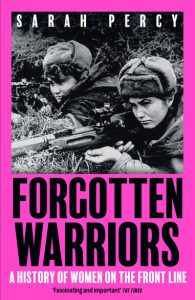Title: Forgotten Warriors: A History of Women on the Front Line
Author: Sarah Percy
Publisher: Hachette/John Murray, 2023; RRP $34.99
Dr Sarah Percy is an associate professor at the University of Queensland and former Fellow of Merton College, Oxford. She was also author and presenter of ABC radio series Why the Cold War Still Matters, and has written Mercenaries, another unconventional military history spanning multiple locations from medieval times to the present.
Forgotten Warriors is approached in the same way. What struck me about this work is how effectively the author tied together all the different strands across nations and recorded history to create a complex, cohesive picture of war itself and women’s roles in it. It is unstintingly relentless in its portrayal of what women can, and have done, destroying any notion that women don’t fight so comprehensively it was tempting just to quote nothing but examples from this work. But a review needs more than just a list.
The central theme of Forgotten Warriors, however, is not whether they were involved, but how women’s involvement in battle has been consistently and systematically concealed or misrepresented by military leaders since early recorded history. The book beginning with the example of the skeleton of a high-ranking Viking warrior surrounded by weapons and a horse being automatically identified as male for over a century until developments in DNA analysis revealed it, to widespread disbelief, to be female.
In her research for Forgotten Warriors Dr Percy uncovers how large a role women have always played in conflict. Records show that female camp followers in European wars between the 15th to the 18th centuries, popularly described in history as wives and prostitutes, played essential support roles including feeding the armies, laundry and medical services, and fighting on the front line itself. Before them were Boadicea and Joan of Arc, and the millions of women who fought and died unnamed. Today women are fighting on the front lines in the Ukraine and Gaza, military and non military, on both sides and everywhere else a war is being fought.
The author identified a number of repeated reasons given for the belief that women do not belong in war. Among these were that it would destroy the bond of brotherhood between soldiers, that women cannot fight, that their presence would distract male soldiers, that on the home front they would be taking men’s jobs, and finally that to acknowledge women as active participants in war was to damage the ‘feminine mystique’ necessary for peace time – at home and in the kitchen.
SAHR Lectures
What her research uncovers, however, is there are far more reasons why women are likely to be involved in war than not, that there is no real basis for the notion that women would sit passively aside while male family members, friends and neighbours went off to fight, or war came through their own front doors.
These discoveries are confirmed by what she details in Forgotten Warriors from when wars were first recorded. Some women, concealing their gender, were involved not for the above reasons but because soldiering was their chosen profession. The author also suggests homosexual or transgender women may also have found military life a safer option than civilian life. More telling is the fact that women were often conscripted, by military leadership bodies discovering repeatedly that wars could not be won without them.
There are countless stories of courage and of brutality, too many too repeat here. Some of the more dramatic include the hugely successful Russian Night Witches flying 24,000 missions using substandard bombers compared to their male counterparts, the terrifying Dahomey, and the Battalion of Death led by Maria Bochkareva. Google them.
Forgotten Warriors is not an easy read. I found it disturbing to find within it, for example, many instances where determination by military leaders to downgrade the input of women often involved putting them in dangerous situations, e.g., the British women in WW2 who manned the huge anti-aircraft battery lights that spotlit attacking German planes. When enemy planes were caught in their sights the women became defenceless targets themselves, because women were not allowed to fire artillery while the men who did the same job could.
A confused sense emerges from history in Forgotten Warriors as it uncovers both military leaders and sometimes the men women fought beside, simply not being able to come to terms with the idea of women in wartime except in terms of needing to be protected, or inevitable victims of collateral damage. Being unable to openly acknowledge the need by women to fight for their own reasons, or essential contribution woman made when they were involved, leaves a gap it seems to have been too hard to traverse.
During WW2 a high-ranking Russian official, Mikhail Kalinan, despite acknowledging that women’s involvement had strengthened the army and improved the behaviour of men, warned the women under his command that, post war,
Do not give yourself airs in your future practical work. Do not speak about the services you have rendered, let others do it for you. That will be better.
Betty Friedman, in her ground-breaking work The Feminine Mystique, would have loved ‘your future practical work’.
I want to stress, however, that the tone of Forgotten Warriors is one of serious military history and not a diatribe against men. Much of it is heartwarming, showing simple camaraderie between individuals fighting and suffering side by side. There are truly amazing, deeply human stories in there, celebrating both men and women at their best and worst in awful situations.
Target audience?
All those interested in military history and especially all those who believe women do not ‘belong’ in wars so they can test their understanding against what lies hidden beneath the other stories we have been told.
Reviewed by: Rhonda Cotsell, March 2024
Ballarat Writers Inc. Book Review Group
Review copy supplied by the publisher

Leave a Reply